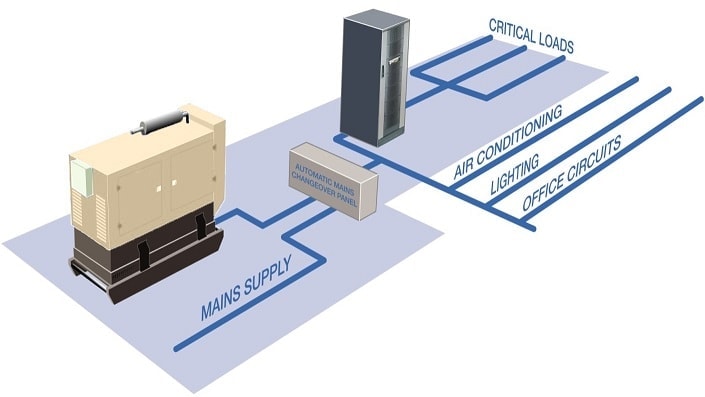A properly-designed online UPS provides its critical load with excellent protection from utility mains power disturbances and brief outages of a few seconds or possibly minutes. However, to ensure uninterrupted power to the load throughout an extended blackout, a generator must be used to complement the UPS.
In this article, Tim Wilkes, Director at KOHLER Uninterruptible Power, looks at the issues that must be recognised and resolved when bringing a generator and a UPS together in a power protection system.
Storms of savage intensity can affect any part of the country at any time, often with little warning. Although the power networks emergency plans are in place and engineers ready to deal with situations as they arise, it’s clear that operators of any data centres with critical significance must take their own steps to ensure uninterrupted power under all circumstances.
Such plans must include provision for power cuts lasting several hours or possibly days, as well as those of just seconds’ or minutes’ duration. This in turn calls for an on-site generator to back up the UPS, as all battery autonomies are finite, and susceptible to be exceeded by a sufficiently extended blackout. Additionally, there is no point in having battery autonomy that is not matched by air conditioning that can maintain safe operating temperatures for the UPS throughout the blackout.
The first step is to recognise that UPSs and generators complement one another in operation, and the second is to ensure that they synchronise smoothly and safely when the power fails.
The UPS is the front line
If a data centre is regarded as mission-critical, it will almost certainly have an online UPS. During normal, ‘mains OK’ operation, the incoming power flows through the UPS rectifier and inverter components before reaching the load. This means that the load is continuously protected from mains-borne noise, surges, spikes, brownouts and any other aberrations, as well as short term power cuts safely within the UPS battery autonomy. Under these circumstances, the UPS is providing full protection without support from the generator, which remains on standby.
However if the UPS control system detects that an ongoing blackout is becoming a threat to its battery autonomy, it could signal the critical load, allowing it to shut down gracefully within the remaining autonomy. Alternatively, if losing the data processing resource is not an option, the UPS must start interacting with an on-site generator. The UPS’s role is then to maintain the supply until the generator can start, stabilise and take over seamlessly as the power source. Assuming the generator has been correctly sized for the application, the UPS will accept it as a ‘mains replacement’ for recharging its battery and supplying the critical load until mains power is restored. This period can be indefinite, subject only to continued availability of fuel for the generator.
The generator as a standby power source
To correctly specify an optimally-matched UPS/generator power protection pair, it’s necessary to look more closely at the generator characteristics and requirements.
The generator converts stored energy – fuel – into electrical energy. It comprises the fuel itself, an engine to develop mechanical energy, and an alternator to convert the mechanical energy into electrical form. Although gas powered generators exist, diesel generators are usually used for base load and standby applications within data centres, so we will consider these here.
The engine is very similar to those found in large lorries, and must be looked after likewise. It must be well maintained with an adequate fuel supply at all times. The battery must be healthy enough to assure reliable starting on demand, while coolant and oil levels should be regularly checked.
The engine drives an alternator, which converts mechanical power into an alternating supply of typically either 230V single-phase or 400V three-phase in the UK. This output voltage’s amplitude and stability is controlled by an Automatic Voltage Regulator (AVR) while the frequency – usually 50 Hz in the UK – is determined by the engine speed. Engine speed and supply frequency are set by a governor, which regulates the amount of fuel fed to the engine; more fuel equals increased speed and frequency.
Both mechanical and electronic governors are available. Mechanical governors, which use springs and spinning weights, are less expensive than electronic types. However, because of their mechanical nature, they are less responsive and provide less stable engine speed and voltage frequency regulation. An electronic governor counts teeth on the alternator’s flywheel as it rotates, and regulates the fuel flow accordingly. Electronic governing is highly responsive and offers very stable speed and frequency regulation; accordingly, it is usually specified for any standby generator intended for use with a UPS system.
In addition to the earlier-mentioned generic requirements, a UPS standby generator should have a mains-powered engine water heater and battery charger. It must also have a communications channel informing of when the mains supply has failed and is subsequently restored, triggering it to start and stop accordingly. This is usually handled by an Automatic Mains Failure (AMF) panel that includes the necessary signals. Fig.1 shows how an AMF panel is used with a generator as part of a protected power installation.
To avoid the AMF starting the generator for every short supply aberration, it is usually set to operate only if the mains fails for an extended time of typically two to 10 seconds. It is equally essential to ensure that the AMF does not stop the generator and switch the UPS back to mains supply immediately it is restored; the reconnection may be part of the utility company’s fault location procedure or the result of an automatic breaker operation. The fault may still exist, causing the supply to be disconnected again almost immediately. Accordingly, most AMF-controlled generators are set to continue to supply power for at least two minutes after the utility supply is restored.
The UPS can sense the brief power interruptions during changeovers at both the beginning and end of the blackout, and uses its batteries to prevent these interruptions reaching the load.
Generator sizing
To ensure the generator performs reliably as a power protection component, it must be correctly sized as well as matched to the UPS. In fact, it should be oversized, especially as it usually supports more equipment than the UPS; air conditioning to cool the equipment as well as emergency lighting, communications and alarm systems.
As a ‘rule of thumb’, 1.5 times the nominal capacity should be allowed for transformerless UPSs, and three times the nominal air conditioning running capacity should be allowed for the air conditioning. These are guidelines only, and advice should be sought from the UPS and generator supplier(s) if independently attempting to size the generator.
Conclusion
If a data centre is providing a critical ICT resource that has to remain online under all circumstances, then an on-site generator must be provided to back up the UPS if a long-duration blackout occurs. Additionally, for successful operation as part of the power protection strategy, the generator must be carefully matched to the UPS characteristics and sized sufficiently to handle all the emergency power needed during a blackout.
References
[1] UK Power Networks Home Page




